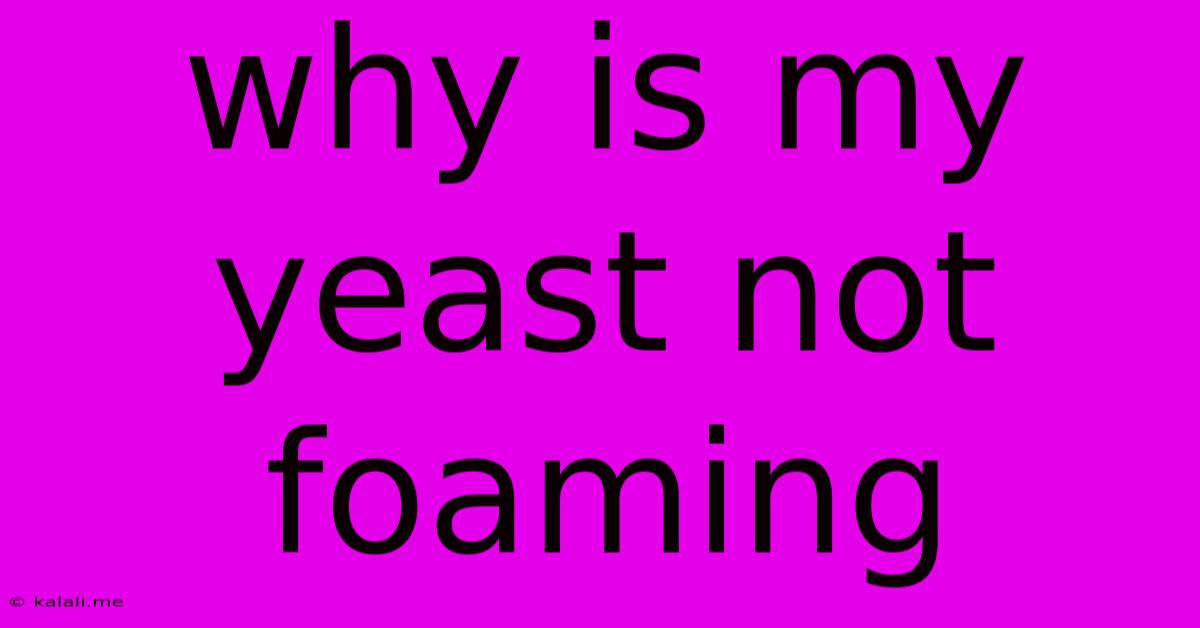Why Is My Yeast Not Foaming
Kalali
Jun 07, 2025 · 3 min read

Table of Contents
Why Isn't My Yeast Foaming? Troubleshooting Inactive Yeast
So, you're ready to bake, you've got all your ingredients measured out, and… nothing. Your yeast isn't foaming, leaving you with a doughy disaster looming. Don't worry, this is a common baking problem with a few simple solutions. This article will explore the common reasons why your yeast might be refusing to activate and provide actionable steps to get your baking back on track. This guide covers everything from checking yeast freshness to understanding the importance of water temperature.
Why is yeast foaming important? Yeast foaming is a crucial indicator that your yeast is alive and active. The foam is produced by carbon dioxide, a byproduct of yeast fermentation. This carbon dioxide is what gives your bread its rise and airy texture. Without it, you'll end up with a dense, flat loaf.
The Usual Suspects: Reasons for Inactive Yeast
There are several reasons why your yeast might not be foaming. Let's break down the most common culprits:
1. Old Yeast: This is the most frequent cause. Yeast, like any living organism, has a shelf life. Expired yeast is often the primary reason for a lack of foaming. Check the expiration date on your package. Even if it's within the date, older yeast can lose its potency.
2. Incorrect Water Temperature: Yeast thrives within a specific temperature range. Too hot, and you'll kill the yeast. Too cold, and it won't activate. The ideal temperature for activating yeast is generally between 105-115°F (40-46°C). Using a thermometer to ensure accuracy is highly recommended.
3. Incorrect Yeast-to-Liquid Ratio: Always follow the instructions on your yeast package carefully. Using too little yeast might result in weak fermentation and less foaming. Conversely, excessively high quantities won't necessarily increase foaming and could negatively impact the final product.
4. Sugar Content: While sugar provides food for the yeast, too much can actually inhibit its activity. If your recipe calls for a large amount of sugar, consider adding it later in the process.
5. Salt Interference: Salt, in large quantities or added too early, can slow down yeast activity. It's generally recommended to add salt after the yeast has had a chance to activate.
6. Other Ingredients: Some ingredients, like acidic liquids (lemon juice, vinegar), can inhibit yeast activity if added too early. These should typically be incorporated later in the process.
7. Poor Quality Yeast: While less common, you might have received a batch of poor quality yeast. Consider purchasing yeast from a reputable supplier.
Troubleshooting Your Yeast Troubles: Step-by-Step Guide
Here's a systematic approach to diagnose and solve your yeast woes:
- Check the Expiration Date: Is your yeast past its prime? If so, replace it.
- Test Your Yeast: Before adding it to your recipe, perform a simple activation test. Dissolve a small amount of yeast in warm water with a pinch of sugar. Let it stand for 5-10 minutes. Foaming should be visible. If not, your yeast is likely inactive.
- Verify Water Temperature: Use a thermometer to ensure your water is within the ideal temperature range.
- Double-Check Your Recipe: Ensure you're following the recipe's instructions carefully, paying close attention to the yeast-to-liquid ratio and the order of ingredient addition.
- Source Fresh Yeast: If all else fails, try a fresh batch of yeast from a different source.
By carefully reviewing these potential issues and systematically troubleshooting, you'll increase your chances of successful yeast activation and delicious, fluffy baked goods every time. Remember, patience and attention to detail are key ingredients in baking success!
Latest Posts
Latest Posts
-
How To Fasten Wood To Concrete
Jun 08, 2025
-
How To Wire Dimmer Switch 3 Way Switch
Jun 08, 2025
-
How To Open A Coffee Bag
Jun 08, 2025
-
How To Wear Armor Dark Souls
Jun 08, 2025
-
Civ 6 Dynamic Turn Timer Pause
Jun 08, 2025
Related Post
Thank you for visiting our website which covers about Why Is My Yeast Not Foaming . We hope the information provided has been useful to you. Feel free to contact us if you have any questions or need further assistance. See you next time and don't miss to bookmark.